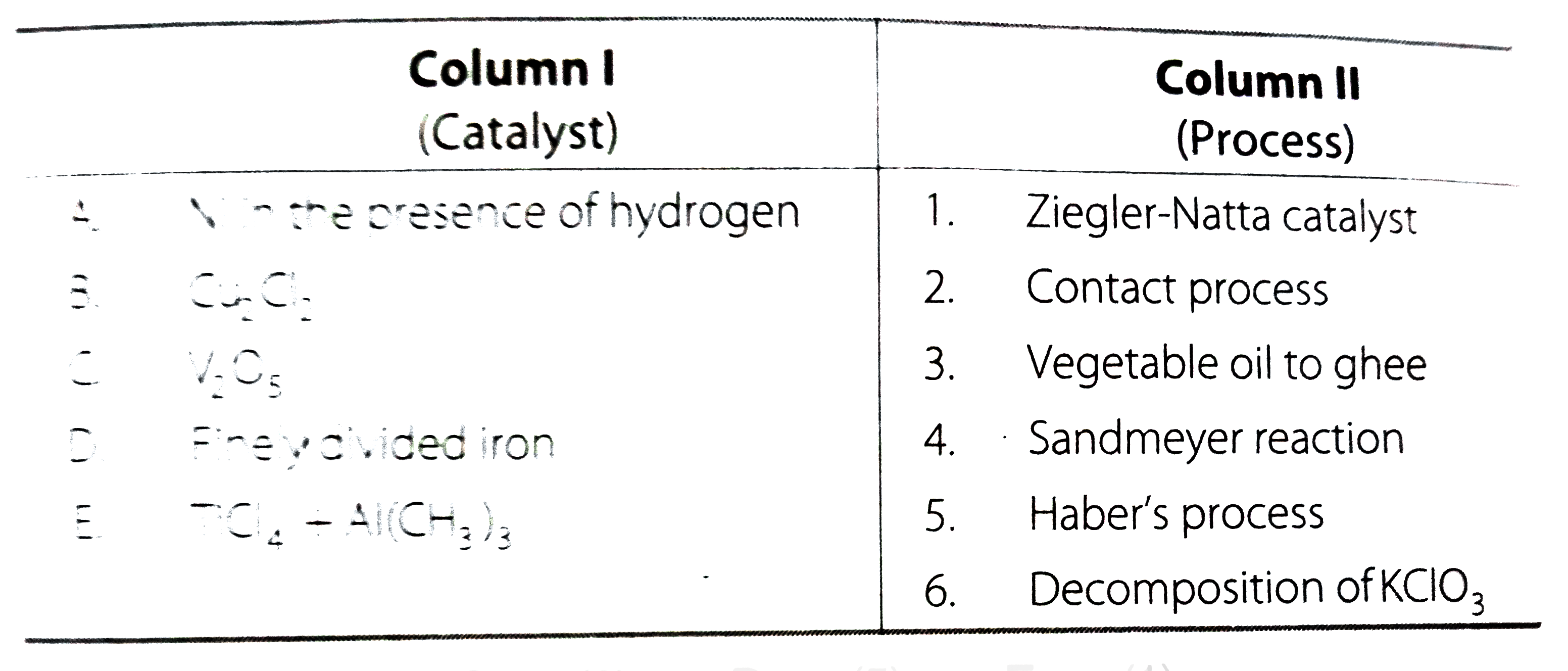Match the cataysts (Column I) with products (Column II).
Column IColumn IICatalystProduct(A)V2O5(i)Polyethylene(B)TiCl4/Al(Me)3(ii)ethanal(C)PdCl2(iii)H2SO4(D)Iron Oxide(iv)NH3
(A)-(iii), (B)-(iv), (C )-(i), (D)-(ii)
(A)-(ii), (B)-(iii), (C )-(i), (D)-(iv)
(A)-(iv), (B)-(iii), (C )-(ii), (D)-(i)
(A)−(iv),(B)−(iii),(C)−(ii),(D)−(i)
The correct Answer is:C
To solve the problem of matching the catalysts from Column I with the products from Column II, we will analyze each catalyst and determine the corresponding product based on known chemical processes.
1. Identify the first catalyst (A: V₂O₅):
- V₂O₅ (Vanadium pentoxide) is commonly used in the contact process for the production of sulfuric acid (H₂SO₄).
- Match: A → (iii) H₂SO₄
2. Identify the second catalyst (B: TiCl₄/Al(Me)₃):
- TiCl₄ in combination with Al(Me)₃ is known as a Ziegler-Natta catalyst, which is used in the polymerization of alkenes to produce polymers such as polyethylene.
- Match: B → (i) Polyethylene
3. Identify the third catalyst (C: PdCl₂):
- PdCl₂ (Palladium(II) chloride) is used in the Wacker process, where alkenes are oxidized to form aldehydes or ketones. Ethanal (acetaldehyde) is a common product of this reaction.
- Match: C → (ii) Ethanal
4. Identify the fourth catalyst (D: Iron Oxide):
- Iron oxide is used in the Haber process for the synthesis of ammonia (NH₃) from nitrogen and hydrogen gases.
- Match: D → (iv) NH₃
Final Matches:
- A → (iii) H₂SO₄
- B → (i) Polyethylene
- C → (ii) Ethanal
- D → (iv) NH₃
Summary of Matches:
- A: V₂O₅ → H₂SO₄
- B: TiCl₄/Al(Me)₃ → Polyethylene
- C: PdCl₂ → Ethanal
- D: Iron Oxide → NH₃
- V₂O₅ (Vanadium pentoxide) is commonly used in the contact process for the production of sulfuric acid (H₂SO₄).
- Match: A → (iii) H₂SO₄
- TiCl₄ in combination with Al(Me)₃ is known as a Ziegler-Natta catalyst, which is used in the polymerization of alkenes to produce polymers such as polyethylene.
- Match: B → (i) Polyethylene
- PdCl₂ (Palladium(II) chloride) is used in the Wacker process, where alkenes are oxidized to form aldehydes or ketones. Ethanal (acetaldehyde) is a common product of this reaction.
- Match: C → (ii) Ethanal
- Iron oxide is used in the Haber process for the synthesis of ammonia (NH₃) from nitrogen and hydrogen gases.
- Match: D → (iv) NH₃
- A → (iii) H₂SO₄
- B → (i) Polyethylene
- C → (ii) Ethanal
- D → (iv) NH₃
- A: V₂O₅ → H₂SO₄
- B: TiCl₄/Al(Me)₃ → Polyethylene
- C: PdCl₂ → Ethanal
- D: Iron Oxide → NH₃
Topper's Solved these Questions
Similar Questions
Knowledge Check
Match the column I with column II and mark the appropriate choice.
Column IColumn II(A)Borax(i)Na3AIF6(B)Inorganic benzene(ii)Na2B4O7.10H2O(C)Cryolite(iii)AI2O3.2H2O(D)Bauxite(iv)B3N3H6A(A) → (ii), (B) → (iv), (C ) → (i), (D) → (iii)B(A) → (i), (B) → (ii), (C ) → (iii), (D) → (iv)C(A) → (ii), (B) → (iii), (C ) → (i), (D) → (vi)D(A) → (iii), (B) → (i), (C ) → (ii), (D) → (iv)Match the column I with column II and mark the appropriate choice.
Column IColumn II(A)C2H2(i)sp3d2 hybridisation(B)SF6(ii)sp3d3 hybridisation(C)SO2(iii)sp hybridisation(D)IF7(iv)sp2 hybridisationA(A)→(i),(B)→(iii),(C)→(ii),(D)→(iv)B(A)→(iii),(B)→(i),(C)→(iv),(D)→(ii)C(A)→(ii),(B)→(iii),(C)→(i),(D)→(iv)D(A)→(iv),(B)→(i),(C)→(iii),(D)→(ii)Match the Column I with column II and mark the appropriate choice.
Column IColumn II(A)Coal gas(i)CO+H2(B)Synthesis gas(ii)CH4(C)Producer gas(iii)H2+CH4+CO(D)Natural gas(iv)CO+N2A(A) → (i), (B) → (ii), (C ) → (iii), (D) → (iv)B(A) → (iii), (B) → (i), (C ) → (iv), (D) → (ii)C(A) → (iv), (B) → (iii), (C ) → (ii), (D) → (i)D(A) → (i), (B) → (iii), (C ) → (i), (D) → (iv)
Match the catalyst given in Column I with the processes given in Column II.

View SolutionMatch the reactions listed in column-I with the products listed in column-II

View SolutionMatch the Column I with Column II.
Column IColumn II(Plant)(Vegetative reproduction by )(a)Turmeric(i)Stolon(b)Crocus(ii)Rhizome(c)Vallisnerla(iii)Aerial shoot(d)Opuntia(iv)Corm
View SolutionMatch the items given in Column 1 with examples give in Column II.
Column IColumn II(a)Hydrogen bond(i)C(b)Resonance(ii)LiF(c)Ionic solid(iii)H2(d)Covalent solid(iv)HF(v)O3
View SolutionMatch the species in Column 1 with the type of hybrid orbitals in Column II.
Column IColumn II(a)SF4(i)sp3d2(b)lF5(ii)d2sp3(c)NO+2(iii)sp3d(d)NH+4(iv)sp3(v)sp
View Solution


